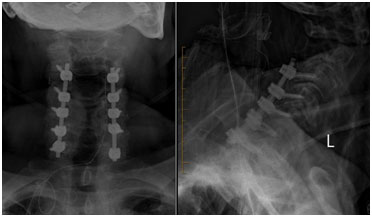Cervical Laminectomy
A cervical laminectomy is an operative procedure of removing the bone (lamina) at the back of the neck (posterior cervical spine) region to relieve pressure on the spinal cord and nerves. Laminectomy refers to removal or cutting of the lamina (roof) of the vertebral bones to provide space for the spinal cord and nerves to exit from the spine.
Why fuse?In most cases, cervical laminectomy can be performed safely on its own without the need for a fusion. The main reason for inserting small titanium screws and rods into the cervical spine is to increase the strength and stability of the cervical spine. It is also an important tool to correct any deformity and prevent future development of “post-laminectomy kyphosis” which will require a more difficult corrective surgery.
Procedure
The surgery is performed general anaesthesia. You will lie on the operating table faced down with your chest and pelvis supported. Your head will be secured in a clamp (Mayfield™), and draped in a sterile fashion. Your surgeon makes a ~10cm incision in the midline of your posterior, and approaches the vertebrae by disconnecting the muscles and retracting them. The lamina is removed with the use of a high speed drill and lifted away from your spinal cord and nerves. Bleeding from the epidural vessels are cauterised.

If a fusion has been recommended, multiple small titanium screws are inserted on both sides and connected to a curve rod for fixation. Bone obtained from your laminae and spinous process is prepared and laid onto the facet joints as bone graft. After the procedure, your surgeon brings back the soft tissues and muscles to their normal place and closes the incision.
Risks or complications
All surgeries carry risk and it is important to understand the risks of the procedure in order to make an informed decision to go ahead with the surgery. In addition to the anaesthetic complications, spinal surgery is associated with some potential risks but not limited to:
- Transient/Long term Nerve injury (especially C5 causing weakness of deltoid and biceps)
- Transient/Long term Spinal cord injury
- Persistent nerve pain, numbness, tingling, burning, aching
- Persistent neck pain, headaches, shoulder pain, scapular (shoulder blade) and interscapular (between shoulder blade) pain
- Infection
- Postoperative hematoma (bleeding)
- Slight reduction in motion of cervical spine
Benefits
- No risk to the vocal cord (recurrent laryngeal nerve)
- Less swallowing difficulties
- If not performing fusion, minimal loss of motion.




